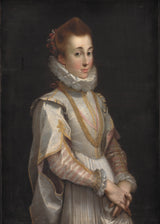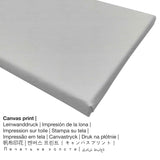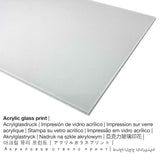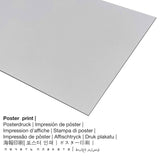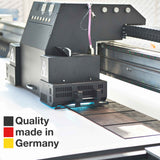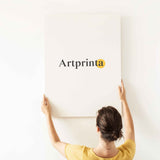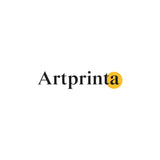Federico Barocci, 1600 - Eserese nwanyị na-eto eto - mbipụta nka mara mma
Ụtụ gụnyere. Mbupu gbakọrọ na ndenye ọpụpụ.
"Portrait of a Young Lady" as an art print
Portrait of a Young Lady mere site na Italian artist Federico Barocci in 1600. Ọzọkwa, ọrụ nka bụ akụkụ nke Statens Museum maka Kunst (National Gallery nke Denmark)'s art collection, which is the largest museum of fine arts in Denmark and is attached to the Danish Ministry of Culture.. The work of art, which is part of the ngalaba ọha a na-enye ya site n'ikike nke National Gallery nke Denmark.Ọzọkwa, ihe osise ahụ nwere akara kredit a: . Nhazi nke mmepụta dijitalụ bụ Eserese ya na oke onyonyo nke 1: 1.4, nke pụtara na ogologo bụ 29% mkpụmkpụ karịa obosara.
Họrọ ụdị ngwaahịa ngwaahịa
Anyị na-enye ụdị dị iche iche nha na ihe maka ngwaahịa ọ bụla. Họrọ n'ime nhọrọ ngwaahịa ndị a ugbu a ka ị kwekọọ na mmasị gị na nha na akụrụngwa:
- Kwaaji: A canvas print is a printed cotton canvas mounted on a wood frame. A canvas produces a unique impression of three-dimensionality. The advantage of canvas prints is that they are relatively low in weight, which means that it is quite simple to hang your Canvas print without the help of any wall-mounts. A canvas print is suitable for all types of walls.
- Glass acrylic e biri ebi (nwere ezigbo mkpuchi iko): An acrylic glass print, often described as a print on plexiglass, will change your favorite original artwork into magnificient wall décor. Additionally, the acrylic glass art print makes a distinct alternative option to canvas or dibond fine art replicas. The artwork will be custom-made thanks to the help of modern UV printing machines. The major upside of an acrylic glass fine art copy is that contrasts and smaller image details will be more visible with the help of the very fine tonal gradation in the print. The real glass coating protects your chosen fine art print against light and external influences for between four and six decades.
- Mpempe akwụkwọ ederede (akwa akwa akwa): A poster print is a printed flat canvas with a slight surface structure, which reminds the original work of art. A poster print is qualified for putting the art replica using a custom-made frame. Please bear in mind, that depending on the size of the poster we add a white margin of approximately 2-6cm around the print in order to facilitate the framing with your custom frame.
- Mbipụta aluminom (aluminium dibbond): Aluminium Dibond prints are prints on metal with an impressive depth. The Direct Print on Aluminum Dibond is your perfect introduction to art prints made on aluminum. For the Aluminium Dibond print, we print the selected artpiece onto the surface of the white-primed aluminum material. The colors are luminous in the highest definition, the details are clear and crisp, and the print has a a matte look you can literally feel.
Ederede iwu: We try our best to depict the art products as closely as we can and to demonstrate them visually. However, the pigments of the print products, as well as the imprint might vary slightly from the representation on your device's monitor. Depending on the settings of your screen and the nature of the surface, not all colors are printed as realisitcally as the digital version. Considering that the fine art prints are printed and processed manually, there may as well be slight deviations in the size and exact position of the motif.
Nkọwa ngwaahịa
| Nkewa bipụta: | mmepụta nka |
| Usoro mmeputakwa: | dijitalụ mmeputakwa |
| Usoro mmepụta: | mbipụta dijitalụ |
| Nlụpụta: | Germany |
| Ụdị ngwaahịa: | mmepụta ihe na-achọ |
| Ojiji ngwaahịa: | art ebipụta gallery, mgbidi ịchọ mma |
| Ndozi onyonyo: | nhazi ihe osise |
| Oke akụkụ onyonyo: | 1: 1.4 |
| Pụtara nha akụkụ: | ogologo bụ 29% mkpụmkpụ karịa obosara |
| Akụrụngwa dị: | ígwè ebipụta (aluminium dibond), acrylic glass print (nwere ezigbo mkpuchi iko), mbipụta akwụkwọ mmado (akwụkwọ kwaaji), akwụkwọ akwa akwa. |
| Ọdịiche dị n'okirikiri akwa akwa akwa (akwa akwa): | 50x70cm - 20x28", 100x140cm - 39x55" |
| Mbipụta iko acrylic (nke nwere ezigbo mkpuchi iko): | 50x70cm - 20x28", 100x140cm - 39x55" |
| Mpempe akwụkwọ mmado (akwụkwọ kwaaji) nha dị iche iche: | 50x70cm - 20x28" |
| Nhọrọ mbipụta aluminom: | 50x70cm - 20x28", 100x140cm - 39x55" |
| Nhazi mmeputa nka nka: | na-enweghị etiti |
Nkọwa gbasara nka
| Aha ọrụ nka: | "Ihe osise nke nwanyị na-eto eto" |
| nhazi ọkwa: | sere |
| Category: | nka ochie |
| Nhazi oge: | 17th narị afọ |
| Afọ nka: | 1600 |
| Afọ nka: | ihe dị ka afọ 420 |
| Egosiputara na: | Statens Museum maka Kunst (National Gallery nke Denmark) |
| Ebe ngosi nka: | Copenhagen, Denmark |
| Weebụsaịtị nke ihe ngosi nka: | Statens Museum maka Kunst (National Gallery nke Denmark) |
| License: | ngalaba ọha |
| Site n'aka: | National Gallery nke Denmark |
Ozi ndabere izugbe gbasara onye na-ese ihe
| aha: | Federico Barocci |
| Aliases: | Fed. Barotius, Barousca Urbino, Federico Barocci da Urbino, Fiori da Urbino, Barrochio Federico, Frederic Barache, Fred. Barrocio, Federigo Barocci, F. Barotchi, M.ro Baro.n, Baroccio Fiori Da Urbino, F. Baroche, Fred. Barozzi, Frederick Barrocio, Baroccio Federigo, Boroetie, Frederico Barrocci, Baronci Federico, le Barroche, Frederigo Barocci, Frederic Baroci, Boroccio Federico, Barochio, F. Barrocio, Federigo Barrocci, F. Barroche, Fed. Baroccio, federico Varrocho, Federico Barocci, baroccio frederico, Barrocio, Barosio, Barozzo, Federigo Baroccio, Federico Barrocio, Barrovo, Baroccioli, Barrocci Federico, Frederico Barochi, fr. baroccio, F. Barocci, Barrocci, Frid. Baroccio, Barocci Federigo, Barroche. F., Barecci, Barozzi, Federigo Baroccio d'Urbino, Baroche, Boraccio Federico, Du Baroche, Barocchi Federico, Fr. Barozi, Fredericus Barotius, Frederico Barozio, Borocio Federico, Fedricho Borosio, Barocci F., Barrocchio, Fiori Federico, Frederic Baroche, Barosio Federico, Friederich Barozio, Barozio, Barozzi Federigo, Barocci, Barecci Federico, Barocchio, Varrozio, Baroccio, Barochius, Barozzi Federico, Federico Barroccio, Baroccir, Barozzio, F. Barocio, Barotius, Federigo Barroccio, Boraccio, Baroch, Boroccio, Barocco, Friederico Barrozzio, Barrozzi, Barrocchio Federico, Barozio Federico, Fridrich Baroccio, Barrochio, Fredericus Barotzus Urbanus, Barocchi, Barroccio, Baronci, Barrocoio, Barozzo Federico, Barotio, Baraccio, Baroccio F., Baroccio Federico, Federico Baroccio, Fred Baroccio, Barroche, Frederigo Baroccio, Federico Baroci Fiorentino, Barroche Federico, Fred. Baroccio, Bertocci, Barocci Federico, F. Baroccio, Barochi, Le Baroche, Federico Barrozio, Barocio Federico, Barroccio Federigo, Baroccir Federico, Frederick Baroccio, Baroccio Frederigo, Federico Baroni, Frederico Baroccio, Federigo Barocci d'Urbino, Barocio, F. Barroccio, Barraccio, Fried. Baroccio, Federico Baroci, Federico Baroccio da Urbino, el Barosio, Federico Varrozio, Frédéric Baroche d'Urbin, Federico Barozzi, Fried. Barochius, Federico Barozi, Frederico Barroccio, Borocio, Barocci Fiori Da Urbino, Barocco Federico, Federigo Baroccj, Fedrigo Baroccio, Barochio Federico |
| okike nke onye nka: | nwoke |
| Obodo onye nka: | Italian |
| Ọrụ nke onye na-ese ihe: | onye na-ese ihe |
| Obodo onye nka: | Italy |
| Nkewa onye nka: | nna ukwu ochie |
| Akwụsị: | 77 afọ |
| A mụrụ: | 1535 |
| Ebe omuma: | Urbino, Pesaro na mpaghara Urbino, Marches, Italy |
| Nwuru: | 1612 |
| Obodo ọnwụ: | Urbino, Pesaro na mpaghara Urbino, Marches, Italy |
Nwebiisinka © | www.artprinta.com (Artprinta)
Additional description from Statens Museum for Kunst (National Gallery of Denmark) website (© nwebiisinka - nke Statens Museum for Kunst (National Gallery of Denmark) - Statens Museum maka Kunst (National Gallery nke Denmark))
The aristocratic female figure stands luminous and cool against a dark background, turning her head towards us, looking down at the spectators whose gazes begin at the elegantly interlaced hands and are led upwards along the arms to the expressive eyes.
The painting's composition The white silk dress shines like mother-of-pearl. The gold necklace echoes the oval formed by the arms, accentuates the curves of the bosom and slides behind the soft semi-transparent ruff that surrounds the face like leaves around a dewy bud.
The painting's mournfeel feel The facial expression is surprisingly lifelike, dreamy, ethereal yet present. Her smile has a slightly mournful feel to it, an effect Barocci achieved by blurring the contours, the corners of the eyes and the mouth with soft colours letting one shape merge into another.
X-ray photography shows that Barocci very deliberately worked his way out of what was originally a more well-defined and static face towards the changeable, indefinable expression we see today.
We do not know who the model was. The style of the painting suggests that it was painted around 1600.

